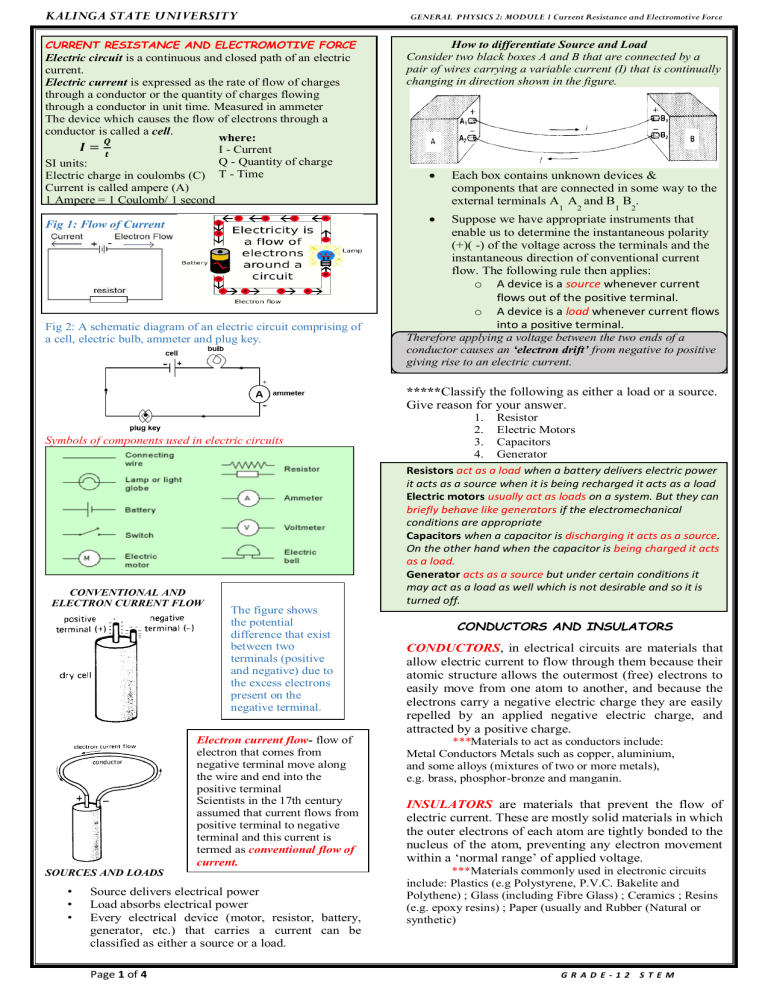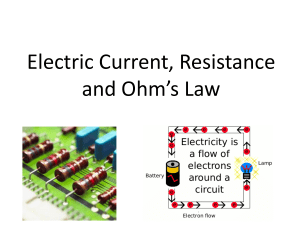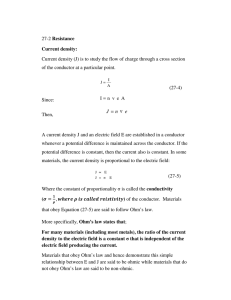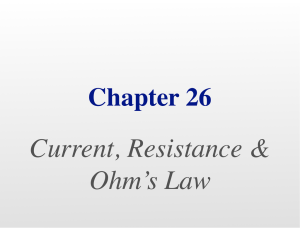
KALINGA STATE UNIVERSITY CURRENT RESISTANCE AND ELECTROMOTIVE FORCE Electric circuit is a continuous and closed path of an electric current. Electric current is expressed as the rate of flow of charges through a conductor or the quantity of charges flowing through a conductor in unit time. Measured in ammeter The device which causes the flow of electrons through a conductor is called a cell. where: 𝑸 𝑰= I - Current 𝒕 Q - Quantity of charge SI units: Electric charge in coulombs (C) T - Time Current is called ampere (A) 1 Ampere = 1 Coulomb/ 1 second GENERAL PHYSICS 2: MODULE 1 Current Resistance and Electromotive Force How to differentiate Source and Load Consider two black boxes A and B that are connected by a pair of wires carrying a variable current (I) that is continually changing in direction shown in the figure. Each box contains unknown devices & components that are connected in some way to the external terminals A A and B B . 1 Fig 1: Flow of Current Fig 2: A schematic diagram of an electric circuit comprising of a cell, electric bulb, ammeter and plug key. 2 1 2 Suppose we have appropriate instruments that enable us to determine the instantaneous polarity (+)( -) of the voltage across the terminals and the instantaneous direction of conventional current flow. The following rule then applies: o A device is a source whenever current flows out of the positive terminal. o A device is a load whenever current flows into a positive terminal. Therefore applying a voltage between the two ends of a conductor causes an ‘electron drift’ from negative to positive giving rise to an electric current. *****Classify the following as either a load or a source. Give reason for your answer. Symbols of components used in electric circuits CONVENTIONAL AND ELECTRON CURRENT FLOW The figure shows the potential difference that exist between two terminals (positive and negative) due to the excess electrons present on the negative terminal. Electron current flow- flow of electron that comes from negative terminal move along the wire and end into the positive terminal Scientists in the 17th century assumed that current flows from positive terminal to negative terminal and this current is termed as conventional flow of current. SOURCES AND LOADS • • • Source delivers electrical power Load absorbs electrical power Every electrical device (motor, resistor, battery, generator, etc.) that carries a current can be classified as either a source or a load. Page 1 of 4 1. 2. 3. 4. Resistor Electric Motors Capacitors Generator Resistors act as a load when a battery delivers electric power it acts as a source when it is being recharged it acts as a load Electric motors usually act as loads on a system. But they can briefly behave like generators if the electromechanical conditions are appropriate Capacitors when a capacitor is discharging it acts as a source. On the other hand when the capacitor is being charged it acts as a load. Generator acts as a source but under certain conditions it may act as a load as well which is not desirable and so it is turned off. CONDUCTORS AND INSULATORS CONDUCTORS, in electrical circuits are materials that allow electric current to flow through them because their atomic structure allows the outermost (free) electrons to easily move from one atom to another, and because the electrons carry a negative electric charge they are easily repelled by an applied negative electric charge, and attracted by a positive charge. ***Materials to act as conductors include: Metal Conductors Metals such as copper, aluminium, and some alloys (mixtures of two or more metals), e.g. brass, phosphor-bronze and manganin. INSULATORS are materials that prevent the flow of electric current. These are mostly solid materials in which the outer electrons of each atom are tightly bonded to the nucleus of the atom, preventing any electron movement within a ‘normal range’ of applied voltage. ***Materials commonly used in electronic circuits include: Plastics (e.g Polystyrene, P.V.C. Bakelite and Polythene) ; Glass (including Fibre Glass) ; Ceramics ; Resins (e.g. epoxy resins) ; Paper (usually and Rubber (Natural or synthetic) GR ADE-12 STEM KALINGA STATE UNIVERSITY GENERAL PHYSICS 2: MODULE 1 Current Resistance and Electromotive Force RESISTANCE Resistance ( R ) is the property of a conductor to resist the flow of electric current through it. 𝑽 According to Ohm’s law R = 𝑰 where: V(voltage) I (current) The SI unit of resistance is ohm (Ω). From ohm’s law; I= 𝑽 𝑹 The current flowing through a resistor is inversely proportional to the resistance. The greater the value of resistance of any conductor, the less current will flow and vice versa “So if the resistance is doubled, then the current gets halved.” If the potential difference across the two ends of a wire is 1 V and the current flowing through it is 1 A then the resistance R of the conductor is 1 ohm (1 Ω ). Factors on which the resistance of a conductor depends: The resistance of a conductor depends upon its: 1. Length 2. Cross sectional area 3. Material of the conductor. Resistance (R) is directly proportional to the length of the conductor and inversely proportional to the area of cross section of the conductor. The resistivity of any material is defined as the resistance of a piece of that material having a length of one metre and a cross sectional area of one square metre (i.e. a cube of material one metre square); the resistivity of the material being the resistance across opposite faces of the standard cube. Resistivity is given the symbol ρ (measured in a unit called the OHM METER, ΩM) (Note: this is not the same as ohms/metre or ohms per metre) The inverse of resistivity is called conductivity (σ). Conductors have large values of conductivity or very small values of ρ. The resistance of any conductor can be found by relating the three factors; Length: = L Cross Sectional Area: = A Resistivity: = ρ The formula can be used to find the resistance (R) of any conductor, providing that its dimensions and its resistivity are known. Sample Problems: PROB#1: Compute the resistivity of the given material whose resistance is 2Ω; area of cross-section and length are 25cm2 and 15cm respectively? Given: RαL R α 1 /A or R α 1/A or R = ρ1/A Where: ρ (rho) - is a constant of proportionality called Resistivity of the material of the conductor. The SI unit of resistivity is ohm meter ( Ωm). Conductors like metals and alloys have low resistivity 10 -8 Ωm to 10 -6 Ωm. Insulators like rubber, glass etc. have high resistivity 10 12 Ωm to 10 17 Ωm. ***Therefore the longer the conductor, the more resistance is present and so less current flows. ***Therefore the greater the cross sectional area, the more current can flow along the conductor, so the lower the value of the conductor’s resistance. R = 2Ω L = 15cm = 0.15m A = 25cm2 = 0.25m2 Solution: Resistance formula is R = ρL / A From resistance formula, Resistivity ρ = RA / L ρ= (2Ω)(0.25m² ) 0.15 m ρ = 3.333 Ω-m PROB#2: The length and area of wire are given as 0.2m and 0.5m2 respectively. The resistance of that wire is 3Ω, calculate the resistivity? Given: R = 3Ω L = 0.2m and A = 0.5m2 Solution: Resistance formula is R = ρL / A From resistance formula, Resistivity ρ = RA / L ρ= (3Ω)(0.5 m² ) 0.2 m ρ = 37.5 Ω-m RESISTIVITY How Materials Affect Resistance Provided that the dimensions (length and cross sectional area) of any conductor do not change, its resistance will remain the same. If two conductors of exactly the same dimensions have a different resistance, they must be made of different materials. One way to describe a material (any material) is by its RESISTIVITY- This is the amount of resistance present in a piece of the material OF STANDARD DIMENSIONS. Page 2 of 4 ACTIVITY NO. 1: In a One whole sheet of bond paper solve the following problems. Show complete solution systematically and box final answers. 1. If the resistance of the wire is 70Ω, what will be the resistivity of a metal wire of 3m length and 0.6mm in diameter? 2. The resistance of an electric wire of an alloy is 20 Ω. If the thickness of wire is 0.002 meter, and length is 2 m, find its resistivity. 3. The resistivity of a metal wire is 20 x 10−8 Ω m at 20°C. Find the resistance of the same wire of 4 meter length and 0.3 mm thickness. GR ADE-12 STEM KALINGA STATE UNIVERSITY GENERAL PHYSICS 2: MODULE 1 Current Resistance and Electromotive Force Temperature Effects on Resistance How Temperature Changes Resistance? Although the resistance of a conductor changes with the size of the conductor (e.g. thicker wires have less resistance to current flow than thinner wires), the resistance of a conductor also changes with changing temperature. This may be expected to happen because, as temperature changes, the dimensions of the conductor will change as it expands or contracts. THE CURRENT I = V/R Any Electrical device or component that obeys “Ohms Law” that is, the current flowing through is proportional to the voltage across it ( I α V ), such as resistors or cables, are said to be “Ohmic” in nature, and devices that do not, such as transistors or diodes, are said to be “Non-ohmic” devices. Increasing the applied voltage V produces more current I to light the bulb with more intensity. These changes in resistance cannot therefore be explained by a change in dimensions due to thermal expansion or contraction. In fact for a given size of conductor the change in resistance is due mainly to a change in the resistivity of the material, and is caused by the changing activity of the atoms that make up the material. Materials that are classed as CONDUCTORS tend to INCREASE their resistance with an increase in temperature. INSULATORS however are liable to DECREASE their resistance with an increase in temperature. Materials used for practical insulators (glass, plastic etc.) only exhibit a marked drop in their resistance at very high temperatures. They remain good insulators over all temperatures they are likely to encounter in use. In a material where the resistance INCREASES with an increase in temperature, the material is said to have a POSITIVE TEMPERATURE COEFFICIENT. When resistance FALLS with an increase in temperature, the material is said to have a NEGATIVE TEMPERATURE COEFFICIENT. “In general, conductors have a POSITIVE temperature coefficient, whilst (at high temperatures) insulators have a NEGATIVE temperature coefficient. Different materials within either group have different temperature coefficients. Materials chosen for the construction of the resistors used in electronic circuits are carefully selected conductors that have a very low positive temperature coefficient. In use, resistors made from such materials will have only very slight increases in resistivity, and therefore their resistance. Using such materials for the manufacture of resistors creates components whose value changes only slightly over a given range of temperature. The three forms of Ohm’s law can be used to define the practical units of current, voltage, and resistance: 1 ampere = 1 volt / 1 ohm 1 volt = 1 ampere × 1 ohm 1 ohm = 1 volt / 1 ampere MULTIPLE and SUB MULTIPLE UNITS Units of Voltage: The basic unit of voltage is the volt (V) Multiple units of voltage are: kilovolt (kV) 1 thousand volts or 103 V megavolt (MV) 1 million volts or 106 V Submultiple units of voltage are: millivolt (mV) 1-thousandth of a volt or 10-3 V microvolt (µV) 1-millionth of a volt or 10-6 V Units of Current: The basic unit of current is ampere (A) Submultiple units of current are: milliampere(mA)1-thousandth of an ampere or 10-3 A microampere (µA) 1-millionth of an ampere or 10-6 A Units of Resistance: The basic unit of resistance is ohm (Ω) Multiple units of resistance are: kilohm (kΩ) 1 thousand ohms or 103 Ω Megohm (MΩ) 1 million ohms or 106 Ω SAMPLE PROBLEMS: Applying OHM’s LAW: PROB#1: OHM’s LAW Ohm's law states that, in an electrical circuit, the current passing through most materials is directly proportional to the potential difference applied across them. SOLN #1: 𝐈= PROB#2: There are three forms of Ohm’s Law: I = V/R V = IR R = V/I 𝟐𝟎 𝐕 SOLN #2: V = 2 A X 12 Ω V = 24 V PROB#3: SOLN #3: 𝐑= where: I = Current (A) V = Voltage (V) R = Resistance (Ω) In practical units, this law may be stated as: amperes = volts / ohms Fig shows A circle diagram to help in memorizing the Ohm’s Law formulas V = IR, I = V/R, and R= V/I. The V is always at the top. Page 3 of 4 𝟓Ω I=4A 𝟗𝐕 𝟑𝐀 R=3Ω ACTIVITY NO. 2: Solve the following problems completely. Present your solution after activity No. 1 1. How much is the current, I, in a 470-kΩ resistor if its voltage is 23.5 V? 2. How much voltage will be dropped across a 40 kΩ resistance whose current is 250 µA? GR ADE-12 STEM KALINGA STATE UNIVERSITY ELECTRIC POWER IN CIRCUITS Electrical Power, (P) in a circuit is the rate at which energy is absorbed or produced within a circuit. “If one joule of work is either absorbed or delivered at a constant rate of one second, then the corresponding power will be equivalent to one watt so power can be defined as “1Joule/sec = 1Watt”. A source of energy such as a voltage will produce or deliver power while the connected load absorbs it. Light bulbs and heaters for example, absorb electrical power and convert it into either heat, or light, or both. The higher their value or rating in watts the more electrical power they are likely to consume. Power (P) = voltage (V) X current (A) unit of measurement :Watt ( W ). Prefixes are used to denote the various multiples or submultiples of a watt, such as: milliwatts (mW = 10-3W) kilowatts (kW = 103W). Then by using Ohm’s law and substituting for the values of V, I and R the formula for electrical power can be found as: To find the Power (P) [P = V x I]: P (watts) = V (volts) x I (amps) also; [P = V2 ÷ R]: P (watts) = V2 (volts) ÷ R (Ω) also; [P = I2 x R]: P (watts) = I2 (amps) x R (Ω) Again, the three quantities have been superimposed into a triangle this time called a Power Triangle with power at the top and current and voltage at the bottom, this arrangement represents the actual position of each quantity within the Ohms law power formulas. The Power Triangle By transposing the basic Ohms Law equation above for power gives us the following combinations of the same equation to find the various individual quantities: GENERAL PHYSICS 2: MODULE 1 Current Resistance and Electromotive Force Likewise, if we have a short-circuit condition, current flow is present but there is no voltage V= 0, therefore 0*I = 0 so again the power dissipated within the circuit is 0. ELECTRICAL ENERGY IN CIRCUITS Electrical Energy is the capacity to do work, and the unit of work or energy is the joule ( J ). So if we know how much power, in Watts is being consumed and the time, in seconds for which it is used, we can find the total energy used in wattseconds. In other words, Energy = power x time and Power = voltage x current. Therefore electrical power is related to energy and the unit given for electrical energy is the watt-seconds or joules. Electrical Power and Energy Triangle To find the various individual quantities: Sample Problem: PROB#1: If a 120 watt light bulb is left-“ON” for 24 hours, how much the energy is consumed? E = P x t = 120 W X 86,400 seconds = 10,368,000 Joules ***prefixes such as kilojoules (kJ = 103J) or megajoules (MJ = 106J) are used instead and in this simple example, the energy consumed will be 10.368 MJ (mega-joules). If the electrical power consumed (or generated) is measured in watts or kilowatts (thousands of watts) and the time is measure in hours not seconds, then the unit of electrical energy will be the kilowatt-hours,(kWhr). If the calculated power is positive, (+P) in value for any formula the component absorbs the power, that is it is consuming or using power. But if the calculated power is negative, (–P) in value the component produces or generates power, in other words it is a source of electrical power such as batteries and generators. Sample Problem: PROB#1: For the circuit shown below, find the voltage (V), the current (I), the resistance (R) and the power (P). Solution: a) Voltage [V = I x R] = 2 x 6Ω = 12V b) Current [I = V ÷ R] = 24 ÷ 6Ω = 4A c) Resistance [R = V ÷ I] = 24 ÷ 2 = 12 Ω d) Power [P = V x I] = 24 x 2 = 48W “Power within an electrical circuit is only present when BOTH voltage and current are present” For example, in an open-circuit condition, voltage is present but there is no current flow I= 0 (zero) therefore V*0 is 0 so the power dissipated within the circuit must also be 0. Page 4 of 4 ***Then our 120 watt light bulb in above example will consume 2,880 watt hours (120W x 24 hrs) or 2.88kWhr, which is much easier to understand the 10,368,000 Joules ELECTRICAL SAFETY For more info read https://opentextbc.ca/physicstestbook2/chapter/electrical-safety-systems-and- Electricity has two hazards. A thermal hazard occurs when there is electrical overheating. A shock hazard occurs when electric current passes through a person. *Electrical safety systems and devices are employed to prevent thermal and shock hazards. *Circuit breakers and fuses interrupt excessive currents to prevent thermal hazards. *The three-wire system guards against thermal and shock hazards, utilizing live/hot, neutral, and earth/ground wires, and grounding the neutral wire and case of the appliance. *A ground fault interrupter (GFI) prevents shock by detecting the loss of current to unintentional paths. *An isolation transformer insulates the device being powered from the original source, also to prevent shock. *Many of these devices use induction to perform their basic function. References: https://www.learnabout electronics.org/Resistors/resistors_01a.php https://www.oakton.edu/user/1/agero/ELT101/Presentations/Chapter0 3.pdf https://www.electronics-tutorials.ws/dccircuits/dcp_2.html https://courses.lumenlearning.com/austincc-physics2/chapter/23-8electrical-safety-systems-and-devices/ GR ADE-12 STEM






